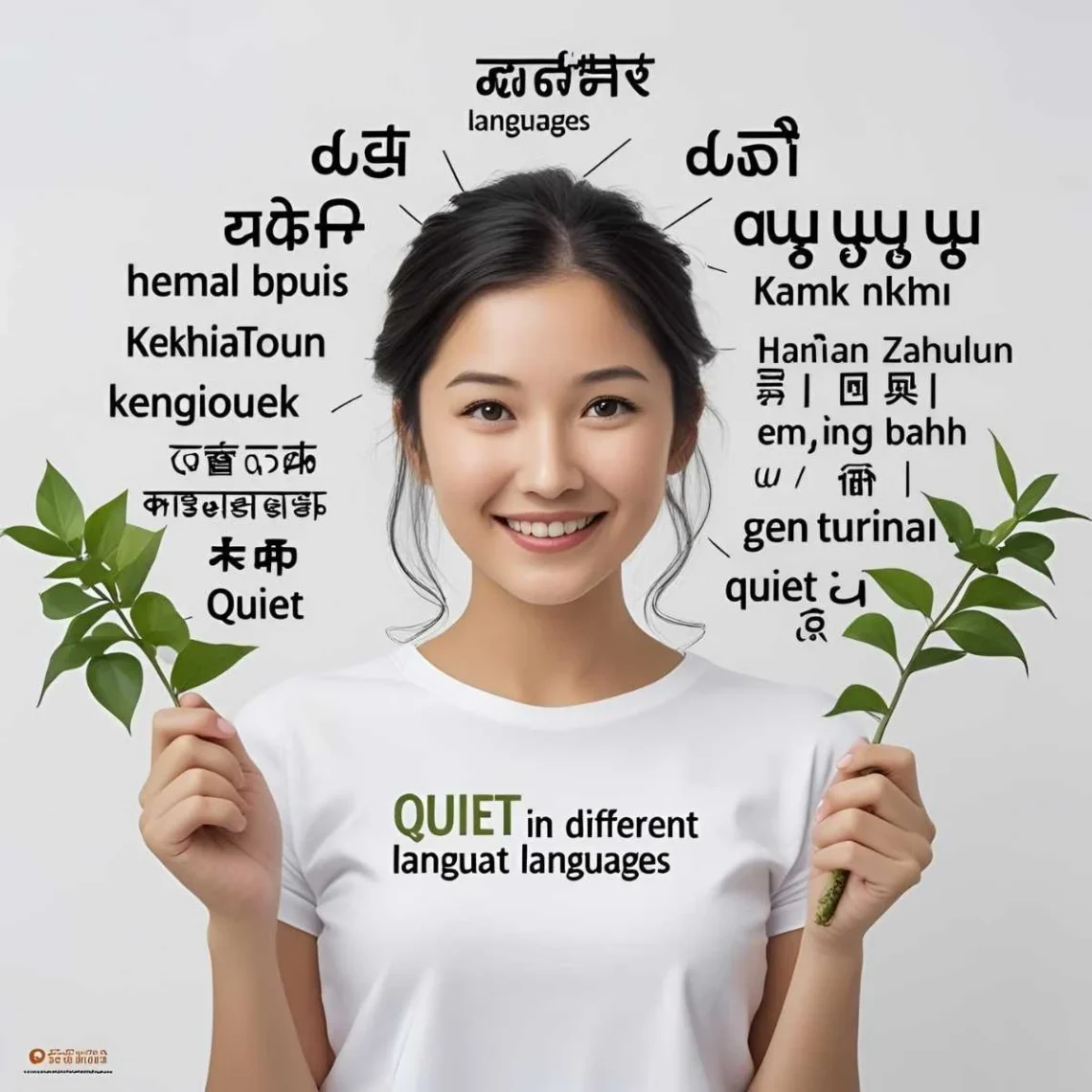Picture a serene moment in a Kyoto garden, where a friend murmurs “shizuka” to hush a conversation, honoring the stillness. The word “quiet” carries a universal call for peace, yet it resonates differently across cultures.
Whether it’s a gentle “silencio” in a Spanish library or a soft “sukut” in a Moroccan medina, “quiet” reflects humanity’s shared desire for calm, shaped by cultural nuances.
Let’s embark on a global journey to explore how people express “quiet” in various languages and what these words reveal about their societies.
Reference Table: “Quiet” in Different Languages
| Language | Word/Phrase | Cultural/Linguistic Insight |
|---|---|---|
| French | Silencieux | Evokes a formal call for silence, used in libraries or theaters. |
| Spanish | Silencio | A poetic term, often used in artistic or solemn settings. |
| Italian | Silenzio | Carries a dramatic flair, common in music and conversation. |
| German | Ruhe | Means “rest” or “calm,” emphasizing tranquility. |
| Mandarin | Ānjìng (安静) | Means “peaceful and quiet,” tied to harmony in Chinese culture. |
| Hindi | Shānt | Means “peaceful,” reflecting India’s spiritual view of calm. |
| Japanese | Shizuka (静か) | Evokes serene stillness, often tied to nature or meditation. |
| Korean | Joyong (조용) | Suggests a calm state, used in respectful or reflective settings. |
| Arabic | Sukut (سكوت) | Means “silence,” used in over 20 countries, tied to reverence. |
| Swahili | Kimya | Means “silence,” used in East Africa for calm or respect. |
| Zulu | Ukuthula | Means “peace” or “quiet,” a warm call for calm in South Africa. |
| Yoruba | Idakẹjẹ | Suggests deep silence, often tied to respect in Nigeria. |
| Maori | Mārie | Means “peaceful” or “calm,” reflecting harmony in New Zealand. |
| Hawaiian | Mālie | Evokes gentle calm, tied to the aloha spirit. |
| Cherokee | Nvwadohiyada | Means “peaceful state,” used in Native American communities. |
European Languages: A Call for Calm
European languages express “quiet” with terms that blend serenity and cultural context. For instance, in French, “silencieux” is a formal call for silence, heard in Parisian libraries or theaters, reflecting France’s respect for order. Meanwhile, Spanish uses “silencio,” a poetic term often used in solemn moments, like during flamenco performances in Spain. Additionally, Italian’s “silenzio” carries a dramatic flair, used in music scores or to hush lively conversations in Rome. In German, “Ruhe” (rest or calm) emphasizes tranquility, often heard in quiet German forests or classrooms. Thus, these terms reflect Europe’s blend of artistic expression and structured calm, from poetic Spanish to pragmatic German.
Asian Languages: Harmony in Silence
Asia’s linguistic diversity shapes unique expressions of “quiet,” often tied to harmony. For example, in Mandarin, “ānjìng” (peaceful and quiet) reflects China’s cultural value of balance, used in settings like tea ceremonies. In Hindi, “shānt” (peaceful) evokes India’s spiritual view of calm, often heard in meditation sessions. Similarly, Japanese uses “shizuka,” a term tied to serene landscapes or Zen practices, conveying stillness in Kyoto’s gardens. In Korean, “joyong” suggests a respectful calm, used in Seoul’s quiet temples. Finally, Arabic’s “sukut” (silence), used across over 20 countries like Egypt and Saudi Arabia, carries reverence, often in religious or reflective moments. These terms highlight Asia’s range, from spiritual calm to respectful silence.
African Languages: Quiet as Community Respect
In African languages, “quiet” often ties to respect and community. For instance, Swahili, spoken in over 20 countries like Kenya and Tanzania, uses “kimya” (silence), a call for calm in markets or ceremonies, reflecting respect. In Zulu, “ukuthula” (peace or quiet) is a warm invitation to calm in South Africa, often used in communal gatherings. Similarly, Yoruba’s “idakẹjẹ” (deep silence) in Nigeria signals respect, used in elder-led discussions. These terms, spoken across diverse African settings, emphasize shared respect and tranquility, often in social or spiritual contexts.
Indigenous & Island Languages: Serenity in Connection
Indigenous and island languages express “quiet” with simplicity and harmony. For example, Maori in New Zealand uses “mārie” (peaceful), reflecting the culture’s focus on balance, heard in quiet marae gatherings. In Hawaiian, “mālie” evokes gentle calm, tied to the aloha spirit, used on serene beaches. Similarly, Cherokee’s “nvwadohiyada” (peaceful state) signals calm in Native American communities, often in storytelling circles. In Samoan, “filemu” (peace or quiet) reflects the Pacific’s communal approach, used in village meetings. Across these cultures, from New Zealand to the Cherokee Nation, “quiet” emphasizes harmony and connection, often tied to rituals.
Cultural Insights: The Evolution of Silence
Words for “quiet” have evolved with cultural values. For instance, Latin’s “silentium” (1st century BCE) influenced Romance languages like Spanish and Italian, tying silence to reverence. In Arabic, “sukut” traces to Islamic poetry, symbolizing spiritual calm. Moreover, in African languages like Swahili, “kimya” reflects trade-era needs for calm communication. In Asia, terms like “shizuka” and “ānjìng” align with philosophies of balance, shaped by Buddhism and Confucianism. These words carry histories of spirituality, trade, and cultural exchange, uniting people in a shared pursuit of peace.
Proverbs and Sayings: Wisdom of Quiet
- French: “Le silence est d’or.” (Silence is golden.) – Highlights the value of quiet reflection.
- Hindi: “Shānt man, santosh dil.” (A quiet mind, a content heart.) – Ties calm to inner peace.
- Swahili: “Kimya ni amani ya roho.” (Silence is the peace of the soul.) – Links quiet to spiritual calm.
- Japanese: “Shizuka na kokoro wa heiwa o motarasu.” (A quiet heart brings peace.) – Emphasizes inner stillness.
- Yoruba: “Idakẹjẹ ni ipa ọgbọn.” (Silence holds the power of wisdom.) – Connects quiet to insight.
FAQs
Why do some words for “quiet” sound similar?
Shared linguistic roots, like Latin’s influence on Romance languages, and cultural exchanges, like Arabic’s impact on Swahili, create similarities.
What’s the oldest term for “quiet”?
Latin’s “silentium” (circa 1st century BCE) is among the earliest, influencing modern European terms.
How do cultures shape the term’s use?
Spiritual cultures (e.g., Asian, African) tie “quiet” to reverence, while pragmatic cultures (e.g., European) focus on order and calm.
Conclusion
From “silencio” in Spain to “kimya” in Tanzania, the word for “quiet” weaves a global thread of serenity and respect. Each term, whether the spiritual “shizuka” in Japanese or the warm “mārie” in Maori, reflects cultural values while celebrating our shared need for peace. Consequently, these words remind us that a call for quiet can unite all people in a moment of calm. How do you say “quiet” in your language, and what does it mean to you? Share your thoughts below—we’re eager to hear your story!






